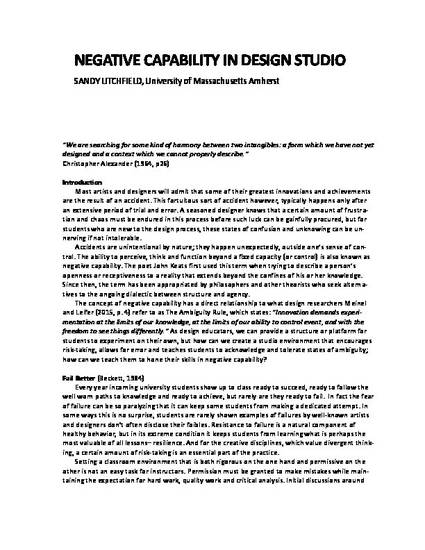
Article
Negative Capability in Design Studio
Charette
(2016)
Abstract
“We are searching for some kind of harmony between two intangibles: a form which we have not yet designed and a context which we cannot properly describe.” [i]
ABSTRACT Most artists and designers will admit that some of their greatest innovations and achievements are the result of an accident. This fortuitous sort of accident however, typically happens only after an extensive period of trial and error. A seasoned designer knows that a certain amount of frustration and chaos must be endured in this process before such luck can be gainfully procured, but for students who are new to the design process, these states of confusion and unknowing can be unnerving if not intolerable.
Accidents are unintentional by nature; they happen unexpectedly, outside one’s sense of control. The ability to perceive, think and function beyond a fixed capacity (or control) is also known as negative capability. The poet John Keats first used this term when trying to describe a person’s openness or receptiveness to a reality that extends beyond the confines of his or her knowledge[ii]. Since then, the term has been appropriated by philosophers and other theorists who seek alternatives to the ongoing dialectic between structure and agency.
The concept of negative capability has a direct relationship to what design researchers Meinel and Leifer refer to as The Ambiguity Rule, which states: “Innovation demands experimentation at the limits of our knowledge, at the limits of our ability to control event, and with the freedom to see things differently.”[iii] As design educators, we can provide a structure or platform for students to experiment on their own, but how can we create a studio environment that encourages risk-taking, allows for error and teaches students to acknowledge and tolerate states of ambiguity; how can we teach them to hone their skills in negative capability?
[ii] John Keats, The Complete Poetical Works and Letters of John Keats (Cambridge Edition. Houghton, Mifflin and Company. 1899), p. 277.
[iii]Christoph Meinel and Larry Leifer, Design Thinking Research: Building Innovators (Switzerland: Springer International Publishing, 2015), p. 4.
Keywords
- Ambiguity,
- Failure,
- Structure,
- Agency,
- Architecture,
- beginning design
Disciplines
Publication Date
April, 2016
Citation Information
Sandy Litchfield. "Negative Capability in Design Studio" Charette Iss. 4 (2016) Available at: http://works.bepress.com/sandy_litchfield/3/
